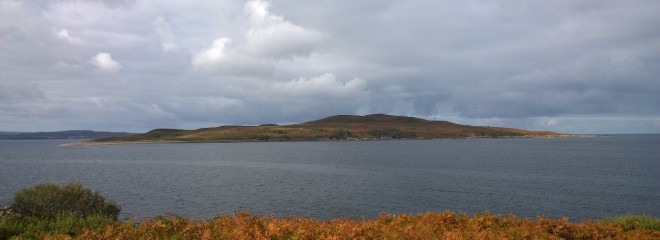Sep 24th, 2014
Author: donich_admin
Aigas – Day 5
This was another big day – we went out to the west coast with much to see and a long drive to get there. The bird group had gone the day before and had brought back an impressive ‘trophy list’ involving five sea eagles and an otter (amongst other things), but they had not been lucky with the weather and it had rained all afternoon.
After a quick briefing in the library with its ‘whole wall’ map of the area (I would like to do one of these at home) we headed out. Today our ranger was Warwick Lister-Kaye (the son of the famous naturalist Sir John Lister-Kaye who runs Aigas) and he was really informative on the geology, history and ecology of the area during the whole of the drive (especially impressive as the microphone in the bus didn’t work properly and he was having to talk really loudly).
First stop was for loos (they always do enough stops for this which is good because there are few things worse than sitting with your legs crossed all the time when you never know if there will be a stop) at a beautiful river gorge where we saw a dipper. Then we headed across the great MAMBO (miles and miles of bugger all) and we learned about what had caused the ‘wet desert’ in parts of the Highlands which I was loosely aware of but didn’t know about in detail. We crossed the geological divide into the coastal area and stopped for pictures of some mountains and ravens and buzzards circling overhead.
Our first stop at the coast was at Gruinard island – which is better known as ‘Anthrax Isle’. During the Second World War an unfortunately flock of innocent sheep were bombed with anthrax spores and (inevitably) died. Having proved their point, the island had to be left alone for 50 years, doused in formaldehyde and then razed before it was safe to visit again (which it is now). This story tells you a lot of what you need to know about humanity.
A little further round the bay we suddenly stopped as Warwick had seen an otter swimming ashore. He quickly set the scope up and we watched it for ages. First it ate the fish it had brought with it, then it had a wash, a scratch and a roll about. Finally it curled up and went to sleep on a rock. This was actually one of the big strengths of this type of holiday. R and I have always been huge fans of just doing our own exploring, but we would not have seen this without guidance from someone who knew the area (the same goes for eagles and other things we saw). It was also the first sighting I have had of an otter really close up – I’ve seen them plenty of times in Shetland, but at the most in the middle distance. I think we may have to buy ourselves a scope when we get back.
We ate lunch near the beach at Mellan Ugrigall (hope I have spelled this correctly as I can’t find it on the map – apparently just means ‘Ugrigall’s field’). There were some strange animal shapes made out of stones which someone had obviously taken trouble with. At this point we saw our first golden eagle – a juvenile perched in a tree in the distance.
We stopped for tea at Loch Maree and discovered why it is the world capital for midgies – although they are long gone elsewhere, here they were still out in force and we had to beat a hasty retreat. On the way home we saw large numbers of red deer preparing for their autumn rut.
We arrived back after 6pm pretty exhausted. Dinner was mushroom soup (you could see some people getting a bit worried in case this was a contribution to the catering by the fungi group from what they had collected that day – but it apparently wasn’t), chicken with olives, capers and prunes (unusual but quite good) and cheesecake. There was a presentation after dinner about British fungi, but I was too tired to go it and went to bed early, ready for another busy day.

